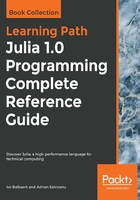
Characters
Like C or Java, but unlike Python, Julia implements a type for a single character, the Char type. A character literal is written as 'A', where typeof('A') returns Char. A Char value is a Unicode code point, and it ranges from '\0' to '\Uffffffff'. Convert this to its code point with Int(): Int('A') returns 65, and Int('α') returns 945, so this takes two bytes.
The reverse also works: Char(65) returns 'A', Char(945) returns '\u3b1', which is the code point for α (3b1 is hexadecimal for 945).
Unicode characters can be entered by a \u in single quotes, followed by four hexadecimal digits (ranging from 0-9 or A-F), or \U followed by eight hexadecimal digits. The isvalid(Char, value) function can test whether a number returns an existing Unicode character: isvalid(Char,0x3b1) returns true. The normal escape characters, such as \t (tab), \n (newline), \', and so on, also exist in Julia.